How to choose a projector for home? Epson Home Projectors 2017 Lineup Review

In March 2016, we talked about the Epson line of home projectors , as well as the main criteria for choosing a projector . Since the models of the middle and upper price segments have been completely updated by now, we decided to run through the entire line again and tell us about the current state of affairs.
Many are already familiar with Epson EH-TW5210 , Epson EH-TW5300 and Epson EH-TW5350 “people's” projectors, the line of which occupies the top places in popularity among projectors for home . In order not to repeat, we invite all interested to learn more about them from the previous post on the topic . To sum up briefly: among the advantages of this line of devices is a successful combination of brightness and color rendition, the absence of a “rainbow effect”, and (in our opinion) a good price for a bright universal full HD projector that is suitable for watching movies and TV shows, and for games (including those demanding delayed image output).
The Epson EH-5XXX line is a base level projectors that are already familiar to you, and we will not tell you anything new about them. But then we will consider the model more abruptly and give specific recommendations on the choice of a projector, depending on the tasks that you plan to set for it.
Epson EH-TW6700
Epson EH-TW6700 is an improved version of the previous model Epson EH-TW6600 . The projector is equipped with built-in stereo speakers in the back of the case, which emphasizes its versatility: the device can be put in the living room or taken somewhere without stationary acoustics. In general, the presence of built-in acoustics in our projectors is an indicator that such products are universal projectors designed for use in various lighting conditions, and not specialized for darkened home theaters.

Epson EH-TW6800 (left) and Epson EH-TW6700 (right)
In fact, it is with Epson EH-TW6700 that a new level of native contrast begins. This is such a contrast that can produce a matrix of the projector without the "tricks" with the aperture and programmed dimming of the image. This is the main reason to choose the new Epson EH-TW6700 instead of the Epson EH-TW5300 , especially if you intend to buy a projector to watch the video in complete or near total darkness . Also, despite the higher levels of “dynamic contrast”, the two older models, the Epson EH-TW6800 and Epson EH-TW7300, do not have a much higher native contrast than the Epson EH-TW6700. This makes Epson EH-TW6700 the absolute champion in terms of price and capabilities among devices of the 6th and 7th lines of projectors.
In addition, the Epson EH-TW6700 produces 3000 lumens of brightness (in white and in colors), which makes it equally suitable for work both in darkened and in illuminated rooms. It is these 3000 lumens of brightness margin that make this model the brightest in the list of models considered in this publication and, accordingly, the most universal, in general.
Therefore, if you are looking for a contrasting, most versatile projector “without problems”, which will perfectly show itself both in a darkened home theater, and in a lighted living room, take this model.
A few words about contrast
If we are talking about a jump in contrast and different segments, we offer you a scheme in which the key differences of Epson home projectors are described very simply:

The contrast of the aforementioned Epson EH-TW6700 is at a level that is expected from home DLP projectors of similar cost, while our devices certainly do not have such a disadvantage as the “rainbow effect” .
Watching movies in the dark on small screens makes sense to use the lamp in economy mode, which gives a combination of sufficient brightness and good black depth, which allows you to enjoy dark scenes, even if the auto-iris is off . We will not tire of repeating this, since the native contrast of the new models is very high .
Technically, the Epson EH-TW6700 has a decent 1.6: 1 zoom level and a fairly flexible manual lens shift setting. This gives more freedom to adjust the image compared to Epson EH-TW5200 / 5300 family of projectors, in which the image is initially shifted upwards by a fixed amount (the lower edge of the picture is slightly below the center of the lens, and in the case of ceiling mounting it is the other way).
Epson EH-TW6700 is set differently - initially the lens is in the center position and the image can be shifted up to 60% vertical height up and down. In other words, you can shift the picture relative to the center of the lens more than the Epson EH-TW5300, and for projecting down it is not necessary to turn the projector over. Side offset is 24% of the image width.
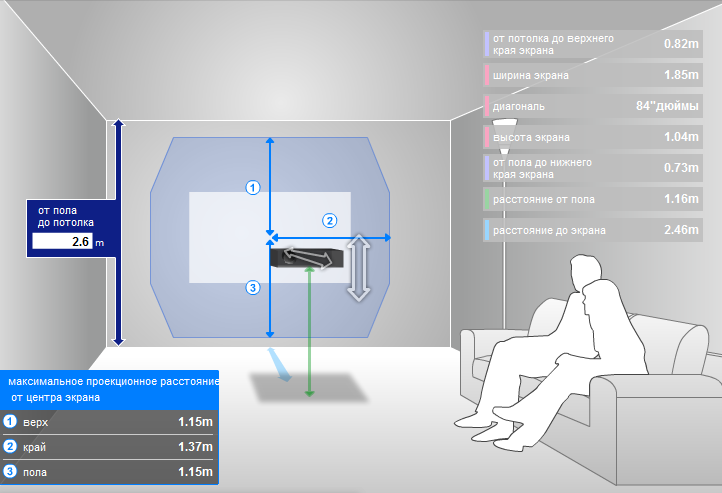
Epson EH-TW6700 Lens Shift Range Visualization
By the way, you can estimate all the parameters of the projector and “try on” it for your premises using the Epson projection calculator .
In addition, a simpler version of the projection calculator , specifically designed for the selection of a home projector, is available.
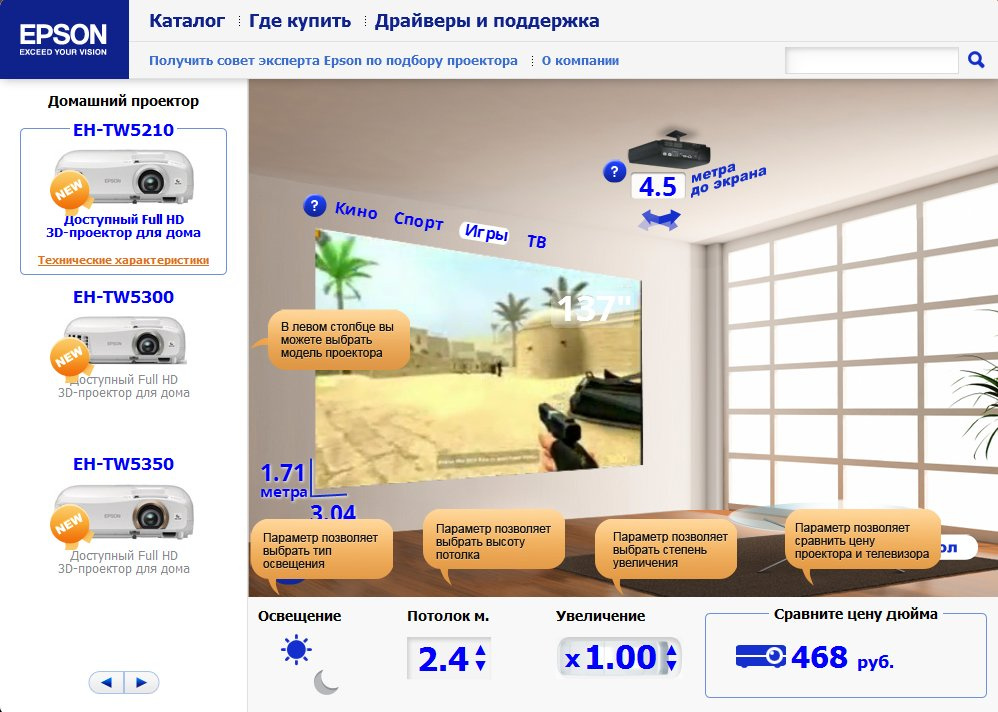
The ratio of the projection (the distance to the screen divided by the width of the screen) for the Epson EH-TW6700 is 1.35-2.15, whereas for the EH-TW5200 / 5300 series - 1.22-1.47. This means that the Epson EH-TW5300 will have a smaller distance from the projector to the screen with the same size of the resulting image. Accordingly, for example, a 100-inch screen with an Epson EH-TW5300 projector can be obtained from a distance of 2.72 meters, while Epson EH-TW6700 should be placed 20 cm further from the screen - at a distance of 2.95 meters.
High brightness allows the projector to easily achieve excellent quality and 3D images, since it is no secret that in 3D mode, some of the brightness of the projector is lost when using 3D glasses. The projector supports 2D to 3D conversion and allows you to select a color mode in 3D. In many projectors, competitors do not have this possibility, since the default projector in 3D “pounding” in the mode of maximum maximum brightness to at least somehow compensate for the loss of brightness. Often - sacrificing color rendition. Our projectors have no such problem.
Among other features is the “Super Resolution” technology, which allows to achieve a visual increase in detailing on high-quality content such as Blu-ray discs. Well, the frame interpolation function allows you to achieve the effect of 60 frames per second when watching standard movies or to add entertainment to sports programs (approx. Epsonic: including cyber sports, especially when all sorts of clever people broadcast at a frequency of 30 frames per second instead of 60 on twitter)
In general, the Epson EH-TW6700 is conceived as a perfectly balanced choice as a home projector / full HD home cinema projector. Considering the previous Epson models, it is worth noting that the much more expensive Epson EH-TW7200 even had a slightly lower native ANSI contrast ratio than the Epson EH-TW6700.
Therefore, the main and very good news is that the contrast is now higher than that of the Epson EH-TW7200 now available in a much lower budget segment!
Epson EH-TW6800
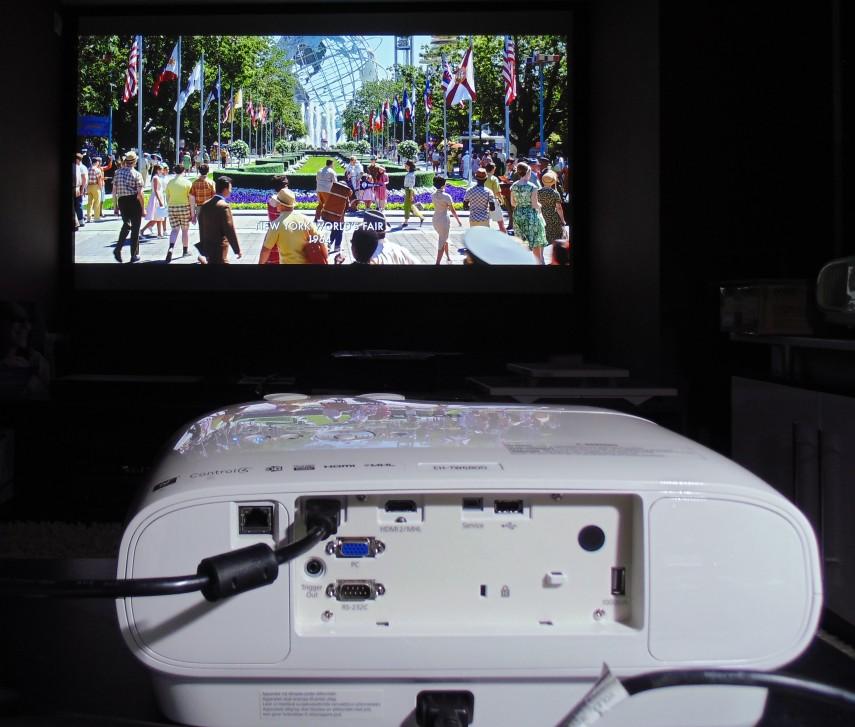
Epson EH-TW6800 in a darkened room
I would call the Epson EH-TW6800 the “special case” of the Epson EH-TW6700, because this model is intended primarily for a darkened home theater . The projector has no built-in speakers, the light output is slightly reduced, and the dynamic contrast is increased. If you dig deeper, you can find out that in all modes except “Neutral” (which is the most accurate), the red and green colors slightly exceed the Rec.709 / sRGB standard. This allows, if necessary, to embellish the picture somewhat, which explains the greater attractiveness of such operating modes of the projector. However, in the "Neutral" mode, it also allows you to achieve the most correct color shades according to the sRGB standard. Therefore, Epson EH-TW6800 is suitable for both perfectionists, who give 100% sRGB, and users who do not mind adding additional “courage” to the picture from the projector.
In addition, active 3D glasses are included with the Epson EH-TW6800. For the rest, in terms of images of the EH-TW6700 and EH-TW6800 are extremely similar. To sum up: if you are looking for the best projector option specifically for home theater, the Epson EH-TW6800 is what you need.
Remark: 4K Enhancement technology, HDR and BT.2020 color space
Epson EH-TW6800 - Epson 6-series top projector, one way or another “limited” by full HD resolution. More and more expensive models of older lines support the reception and playback of 4K content using proprietary hardware and software technology "4K Enhancement" . Thus, in this guide, we are also passing the line between 4K and non 4K-ready projectors.
The point is that 4K not only solves the problem of displaying material in 4K, but also allows you to improve the image, largely getting rid of the pixel grid . As soon as the 4K-enhancement mode is activated, a much more subtle mechanism for accurately increasing the sharpness of full HD content than the familiar “Super Resolution” on traditional full HD projectors is available to the user, which makes it possible to increase sharpness using the advantage of 4K resolution. When working with high-quality sources full HD-signal, this gives a noticeable and very pleasant result.
However, we all understand that the time when 4K was “indulgence” or an additional function was over. Now 4K support also means support for HDR , HDCP 2.2, as well as the projector's “understanding” of the BT.2020 color gamut. Recall that at the moment we are talking about the transition to the standard BT.2020 as a container in which data is encoded. In other words, the color of BT.2020 is when 100% red is not sRGB red, but BT.2020 is red, close to pure red with a wavelength of 630 nm. With BT.2020, you can encode content with sRGB color, or DCI color, but the BT.2020 itself is not very relevant yet, because the entire range of colors described by its color space is not yet able to reproduce any of the known electronic devices.
Epson high-end projectors
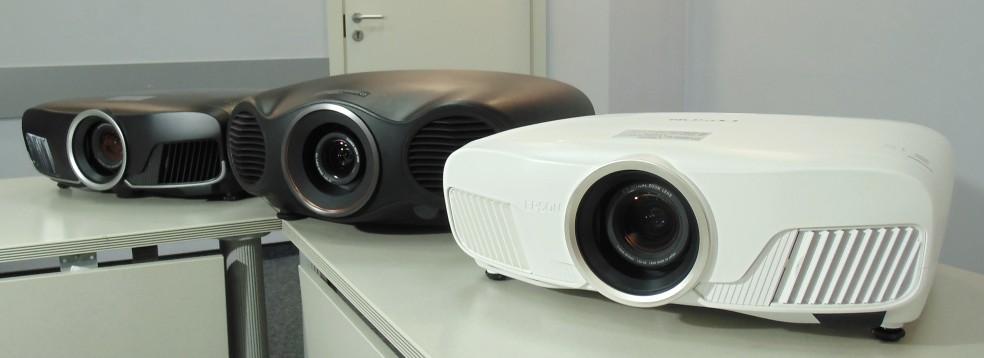
If we analyze the market, we see that 4K, HDR and all the above possibilities - all this currently belongs to the elite segment of projectors. At Epson in this class, everything is simple, because The two best models of the category are available: Epson EH-TW9300 and Epson EH-LS10500 .
In fact, these two models represent two completely different price segments. The Epson EH-TW9300 is an entry-level High-End, and it has the combination of advanced features and performance characteristics required by a High-End projector. Traditionally, the Epson EH-TW9000 series has been an “affordable high-end”. This trend continues, but the bar has risen. In addition to a set of functions related to the support of 4K and Ultra-HD, this model has a lens and body corresponding to its status, as well as, more importantly, native contrast up to 10,000: 1 (and dynamic - just rolls over).
Wait. What about the Epson EH-TW7300?
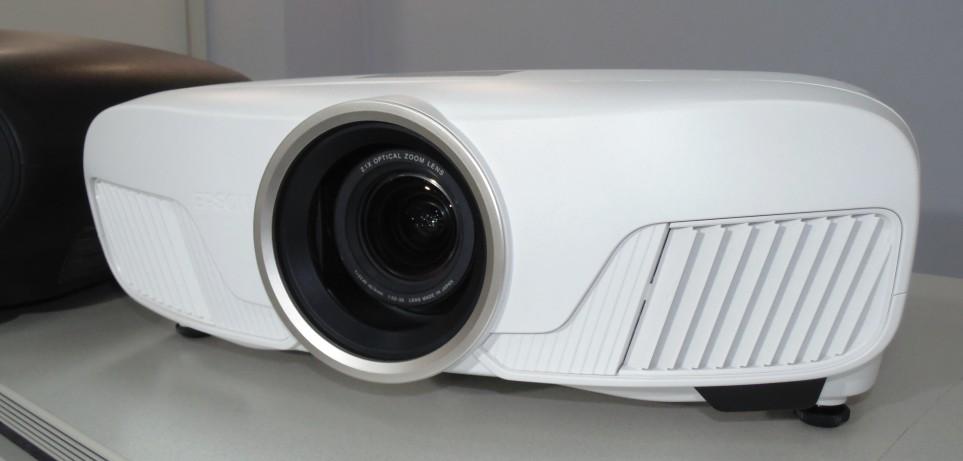
Model Epson EH-TW7300 is very interesting. This projector has a native contrast close to the middle group (Epson EH-TW6700 and Epson EH-TW6800), but receives all (or almost all) "bells and whistles" from the older Epson EH-TW9300 , for which many users prefer it. These are also those who could initially focus on the Epson EH-TW6800 for their home theater, but wished to pay extra and get improved image quality, 4K support, and increased installation convenience. Those who initially choose the projector "more expensive" just for the living room, and not for the darkened room of a home theater, can choose Epson EH-TW7300 instead of Epson EH-TW9300, rightly assuming that the high-end contrast level in the living room is most likely not will give the expected benefits, but the ability to get the most advanced features in combination with excellent brightness and excellent color reproduction at this brightness is just what you need.
So, let's go through the possibilities of Epson EH-TW7300.
4K support. 4K Enhancement technology, HDR, BT.2020 color support. All this not only allows you to play 4K and UltraHD Blu-Ray, but also provides a significant advantage when displaying full HD content - a smoother, almost “analogous” -smooth image on monophonic scenes. Generally speaking, Epson is, if not the first, then among the first to bring 4K support to this price segment.
DCI color gamut. When viewing in “Cinema” mode, you get the DCI color by using a specialized film filter. The color expands from sRGB to DCI, while preserving the realism of the image and not giving it obvious undesirable shades, but at the same time you will be amazed by the variegation and purity of colors on those scenes where the motley colors were originally intended. In almost any mode, you can get as close as possible to the passport brightness of the projector. Yes, you guessed it. Because 3LCD and "color brightness".
Two modes of brightness. When viewed in a dark room, the Epson EH-TW7300 turns on a cinema filter, which reduces the brightness to a level that is ideal for home theater. Since this is done optically and not by color correction of the matrices, it is possible to maintain a high level of contrast without any problems. However, in the “Neutral” mode, when the film filter is turned off, you get an exact image that conforms to the sRGB standard, with a brightness close to the maximum brightness of the projector, which is perfect for slightly lit rooms.
Top body and lens. If we consider the body and the lens as a single complex, then the Epson EH-TW7300 and Epson EH-TW9300 are almost identical. Lens control is motorized, not manual. Even the lens cover is automatic. There is a function of memory settings lens. The zoom is 2.1: 1. Vertical shift - 96% (the lower part of the image is where the upper one was originally). The horizontal shift is 47% (the side of the image is where the center of the screen used to be). The case itself is designed so that it allows to further reduce the noise of the work. The projection ratio is 1.35-2.84 (i.e., the minimum distance to the screen is like that of the Epson EH-TW6700 and Epson EH-TW6800). Of course, this is a big, if not huge, leap in terms of flexibility and convenience compared to the younger models.
Advanced settings. The Epson EH-TW7300 has features such as image setting memory (10 cells), matrix flattening control (digital), and uniformity and white balance adjustment across 8 screen sectors relative to the center, separately for eight brightness levels.
In addition to the above, you can also mention that both models support sharpening and frame interpolation in both 2D and 3D modes.
Accurate operation of the auto iris. Epson EH-TW7300 is equipped with an automatic aperture, which, as befits a top projector, works neatly and smoothly. Apparently, the Epson EH-TW7300 and Epson EH-TW9300 aperture work in a similar way, so in the end, even lower-level projectors can demonstrate a more noticeable effect with faster blackout. At Epson EH-TW7300, this process occurs so smoothly that it is sometimes difficult to even notice the activation of the diaphragm by ear without ear to the projector body.
As a result, Epson EH-TW7300 is not just a good projector from the average price group, but also a very interesting model with a rich set of additional functions borrowed from the High-End segment. Compared with its predecessor, that is, with the Epson EH-TW7200, the Epson EH-TW7300 not only became better in all respects, but also moved from the section full HD projectors to 4K projectors. The image is better thanks to 4K Enhancement and DCI color gamut. The projector has become a little more suited for working in the dark and much better for working in a partially lit room.
But the price has changed a bit, yes.
Epson EH-TW9300
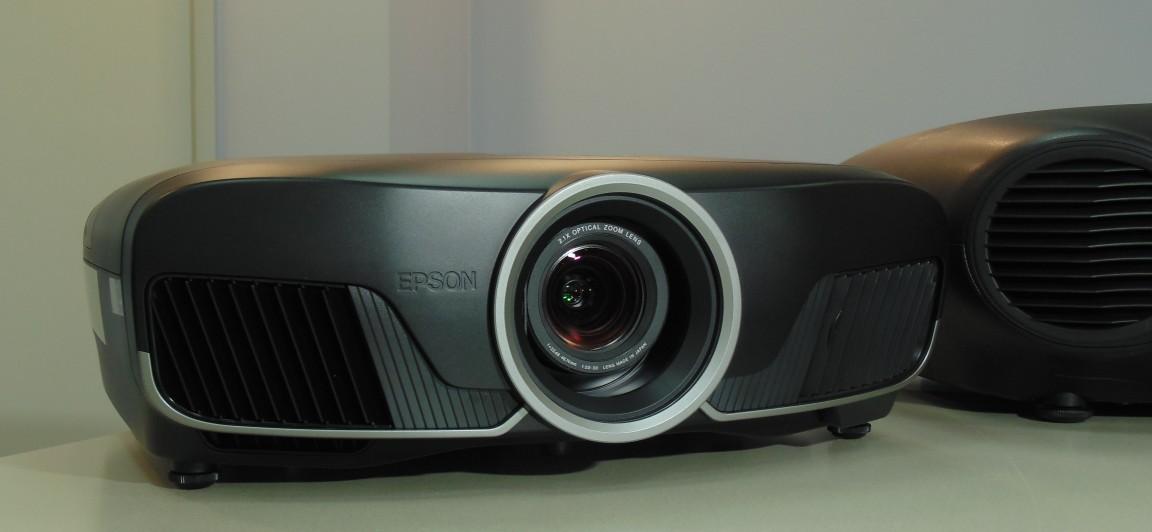
Since Epson EH-TW9300 transferred practically all of its “skills” to the lower-end Epson EH-TW7300, we can say that all that was described above about Epson EH-TW7300 applies to it. For many years, the Epson EH-TW9000 series of projectors have passed the baton of “affordable High-End” to each other.
There is no special point in talking about dynamic contrast - the projector can almost completely block the luminous flux, a tremendous contrast value is achieved, and everything else that any vendor who has mastered this method of increasing the contrast of dark scenes tells you ... The situation with the native contrast is more interesting than five times higher than Epson EH-TW7300 . Accordingly, the quality of the implementation of HDR at the same time automatically switches from “HDR support” to “uniquely HDR”.
Actually, this could be limited to - obviously, these two projectors, for all their external similarities, are still different. And the Epson EH-TW9300 can easily compete with any more expensive device and, if a potential buyer is interested in value for money, this model will be of great interest. And if you can afford it, then without a doubt, first visit one of our demo machines to see firsthand what an elegant picture you can get from it.
Epson EH-LS10500
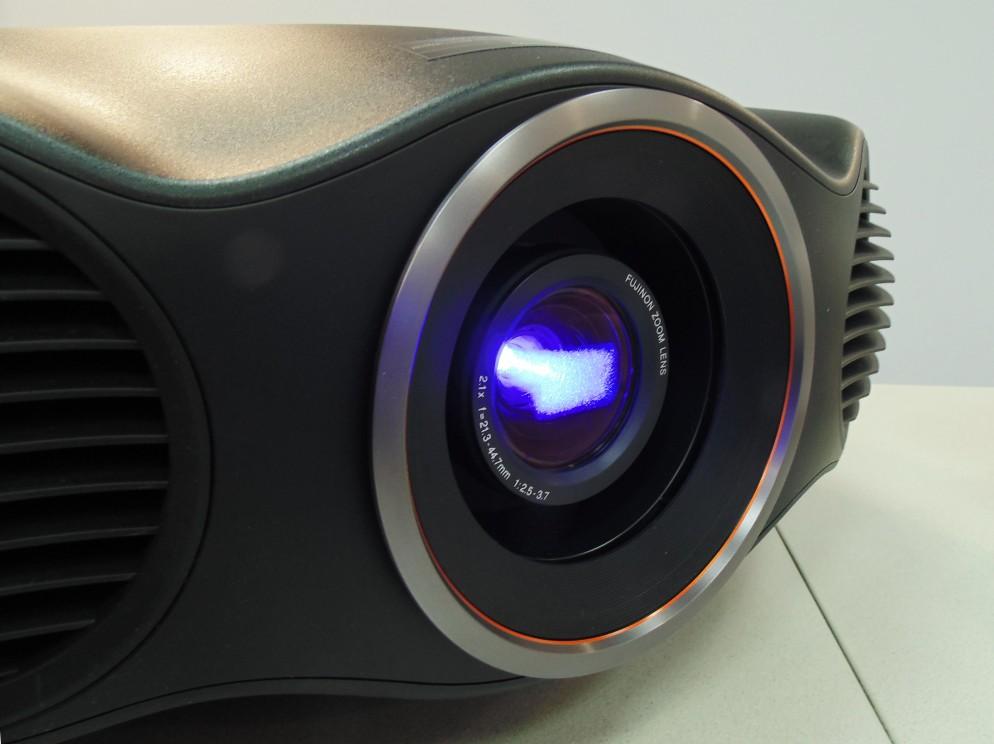
In 2015, we entered the market for high-end laser projectors Epson EH-LS10000 , based on the new technology "3LCD Reflective" , which provides another breakthrough in the field of natural contrast. The laser light source is, in fact, eternal, providing up to 30,000 hours of operation , increased reliability and endless dynamic contrast . The noise level is noticeably reduced even compared to the Epson EH-TW9300. However, this model does not have the same high range of brightness, and is a specialized projector for home cinema. By the way, we have already told you about it in a blog .
Upgrading to Epson EH-LS10500 is connected, for the most part, with the addition of full HDR support at the level that is required today for playing Blu-Ray UltraHD and other content. For projectors in this segment, this has already become mandatory and Epson is not far behind.
This model has many small advantages that make up a higher level of image quality. For example, interpixel intervals are reduced, which reduces the visibility of the pixel grid. In general, any presentation of this projector, as well as similar models from competitors, is a long list of various subtleties, with special emphasis on the high quality of individual components, such as a lens, phosphor, contrast, etc., etc., which you can find out in the corresponding section. our site .
In conclusion, I would like to say once again that the Epson EH-LS10500 is least similar to all other models - it uses a number of new technologies. Although the 4K Enhancement technology was first used on this projector (more precisely, in its predecessor, Epson LS10000), after which it moved to lower segments after some time, the 3LCD Reflective matrix technology and laser light source still make this model unique in Epson projectors and Epson Home Cinema Projector.
Thanks for attention
We hope that helped to figure out what and how. Questions?
')
Source: https://habr.com/ru/post/403777/
All Articles